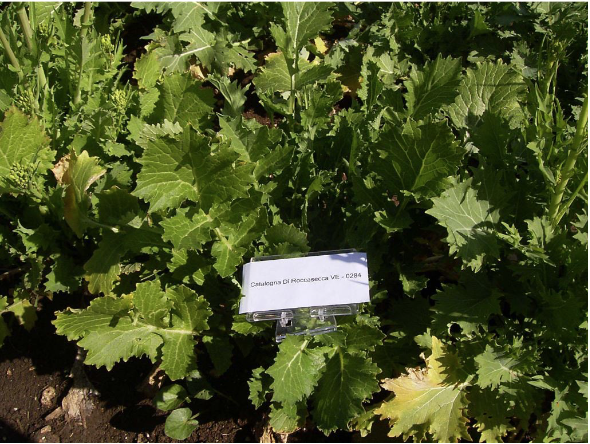Crop: Brassica rapa L. subsp. sylvestris var. esculenta (Turnip greens)
Some historical records report the cultivation of ‘Rapa Catalogna di Roccasecca’ (B. rapa spp. sylvestris) in the municipality of Roccasecca (ARSIAL, 2019).
The landrace is cultivated for the consumption of its flower sprouts and the young leaves. It is generally sown between the end of August and mid-September; even if some farmers sow directly on the field, sowing is traditionally carried out on in trays: after about a month young plants are transplanted manually or mechanically. After the transplantation, palnts are irrigated abundantly. Throughout October and November weeds are removed from the fields. The harvest begins when temperatures drop down, generally in December. However, plants of ‘Rapa Catalogna di Roccasecca’ continue to produce edible parts until mid-March.
Cultivation System: conventional conditions.
Geographical Information
Country: Italy
‘Rapa Catalogna di Roccasecca’ is typically cultivated in the municipalities of Roccasecca, Pontecorvo, Castrocielo, San Giovanni in Carico, Col Felice, Rocca d’Arce and Colle S. Magno (Frosinone, Italy). Within the production area, the soil is rich in organic matter and generally characterised by a medium texture.
Farmer(s) description:
Within the cultivation area relatively few farmers still cultivate ‘Rapa Catalogna di Roccasecca’. Each farmer produces his seed; generally, they do not generally exchange seed lots.
Generally, this landrace is also maintained in private gardens.
Farmer unconsciously might select plants characterised by highest level of heterozygosity, and many alleles can be consequently maintained across generations. This way Brassica plants can generally retain a high level of intra-population diversity (Ciancaleoni et al. 2014)
Propagation system: Seed, cross-pollination
Multiplication procedures and consequences on landrace diversity:In order to save the seed and preserve the landrace, the most appetizing, large and healthy turnips on land at the time of harvest, are chosen. Those that match the characteristics of the landrace are selected, discarding those with white skin. The selected turnips are transplanted together to another area of the garden that is free of crops and there they are left until they bloom and fruit. When the seeds are ready, carefully the stem needs to be cut by the base and let it dry. Afterwards, the fruits are broken by rubbing them between the hands and, if desired, they can be sifted and winnowed to obtain the clean seed of other remains.
Management plan existence:The landrace management relies completely on farming activities in the area.
Added Values
The landrace is very appreciated on the local market (Lazio Region), also due to the several initiatives carried out by local authorities to save the landrace by promoting its cultivation and market.
Others (e.g. commercial/geographical brands or special traits):In order to encourage the cultivation and promote ‘Rapa Catalogna di Roccasecca’ on the local market, the association named ‘Le Vie’ established a festival during which the product is directly used to prepare traditional curses. The event takes place in Roccasecca (Frosinone) every year, in December.
In 2011 ‘Rapa Catalogna di Roccasecca’ was included into the Regional Register of Genetic Resources of Lazio Region (Italy) following the implementation of the Lazio Region Law (n. 15, 1st March 2000 (http://www.arsial.it/arsial/wp-content/uploads/page/n.1-legge-regionale.pdf) which is aimed at safeguarding and promoting the cultivation of local genetic resources).
The Lazio Region, through its body called Agenzia Regionale per lo Sviluppo e l’Innovazione dell’Agricoltura del Lazio (ARSIAL, Regional Agency for Agricultural Innovation and Development of Lazio), established a Regional Network for In Situ Conservation and Use of Genetic Resources. The network gives implementation to the above-mentioned Lazio Regional Law. A small monetary contribution is provided to the farmers adhering to the network for maintaining landraces. The network is also aimed at facilitating the exchange of seeds within the network members.
Currently, ARSIAL gives technical support to landrace maintainers; recently, a morpho-phenological characterisation of six different accessions of ‘Rapa Catalogna di Roccasecca’ was carried out.
Despite its modest economic impact at the national level, this landrace is very important not only to preserve a traditional regional product but also from a biodiversity point of view as source of genetic variation.
Uncertain. To have access to the resource ARSIAL should be contacted (http://www.arsial.it/arsial/contattaci/)
Case study prepared by Dipartimento di Scienze Agrarie, Alimentari e Ambientali (DSA3), Università degli Studi di Perugia (UNIPG), Italy.
Most of updates have been communicated by Dr Paola Taviani (ARSIAL).
- Ciancaleoni S, Raggi L, Negri V (2014) Genetic outcomes from a farmer-assisted landrace selection programme to develop a synthetic variety of broccoli. Plant Genet Resour 12:349–352. doi: 10.1017/S1479262113000592
